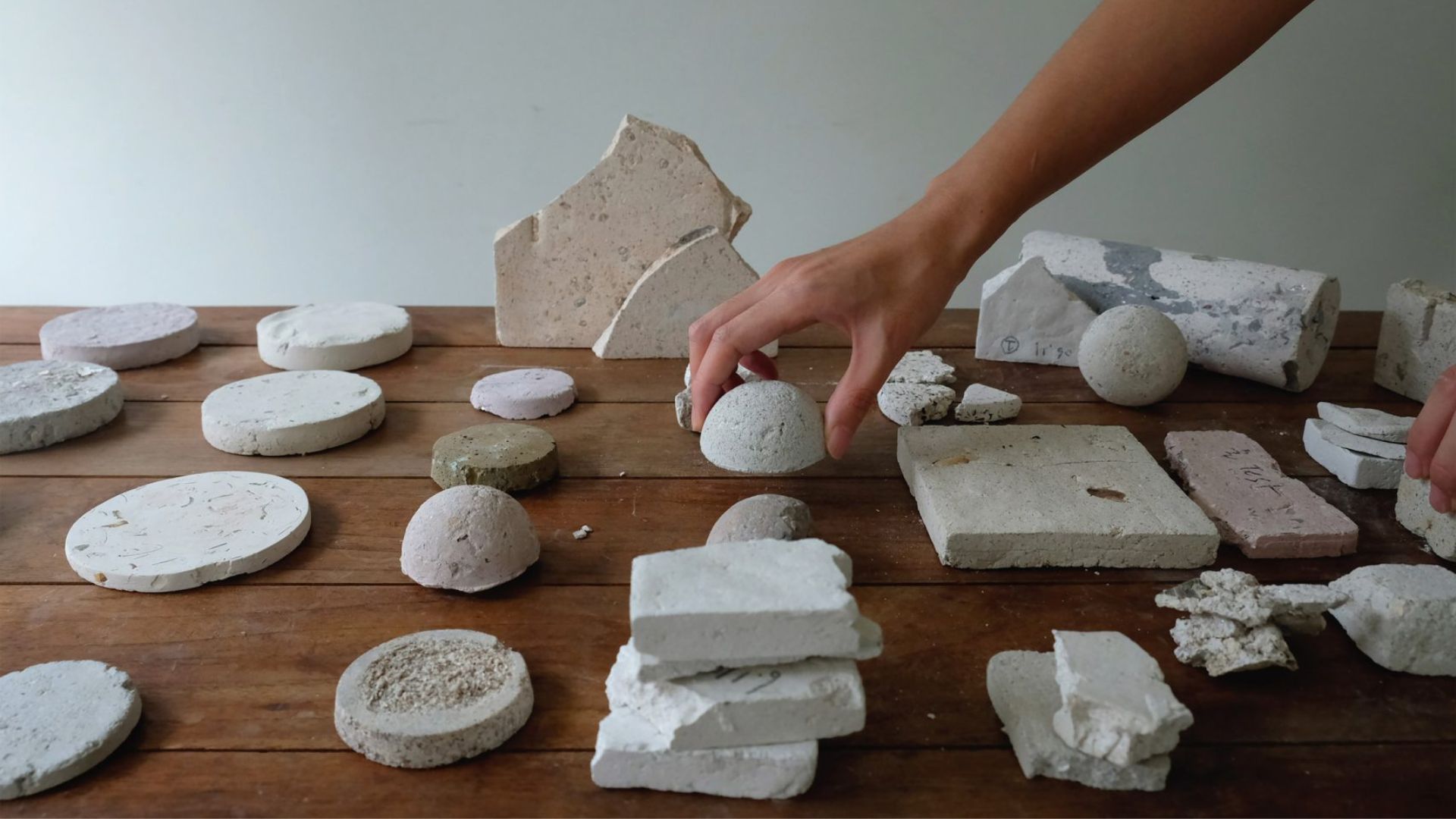Material innovations aimed at reducing concrete’s carbon footprint
From making use of everything from algae-grown limestone to olivine – researchers are focusing on finding low-carbon substitutes for cement

Today, as the world and the Global Cement and Concrete Association (GCCA), in particular, race to reach net-zero emissions by 2050 to avoid the worst effects of climate change – researchers are working to decarbonise concrete, one of the most polluting materials in the world.
Did you know concrete’s key ingredient cement currently accounts for about eight percent of the world’s global carbon emissions?
From utilising algae-grown limestone to olivine – a growing number of eclectic material innovations are emerging to tackle concrete’s carbon footprint.
Scroll to explore our round-up of five of the most innovative materials, alternative to concrete and cement!
1. Gent Waste Brick by Carmody Groarke, TRANS Architectuur Stedenbouw, Local Works Studio and BC Materials
To form the new wing of the Design Museum Gent – architecture studios Carmody Groarke and TRANS Architectuur Stedenbouw collaborate with material researchers to develop a brick crafted from local construction waste.
Low-carbon – the Gent Waste Brick is designed together with circular economy specialist Local Works Studio and materials manufacturer BC Materials.
It’s made from 63 percent recycled municipal waste sourced from Ghent, collected from a local recycling center for demolition concrete and glass.

These recycled materials are further mixed with Lommelzand sand from the Belgian municipality of Lommel and bound together with hydraulic lime and ground calcium carbonate.
Reducing the amount of energy needed to produce them – these bricks are cured in a humid environment for two weeks and left to air-dry rather than being fired.
The material gets its strength through the process of mineral carbonation, which involves the calcium carbonate in the brick reacting with carbon dioxide in the surrounding air.
“This process, coupled with the use of recycled composites, results in a brick with 0.17 kilograms of CO2e per kilogram!” says the studio.
2. K-Briq by Kenoteq
A sustainable building brick that’s unfired and fabricated from 90 percent construction waste – Scottish startup Kenoteq launches K-Briq.
Generating less than a tenth of the carbon emissions in its manufacturing process than a regular brick – it’s invented by engineering professor Gabriela Medero at Edinburgh’s Heriot-Watt University.
“I’ve spent many years researching building materials and have been concerned that modern construction techniques exploit raw materials without considering that they’re amongst the largest contributors to carbon emissions – the amount of waste they produce is not sustainable long-term!” says Medero.

On the other hand, K-Briq looks like a normal brick and weighs the same but offers better insulation properties as well as can be produced in any color.
Along with saving energy in the manufacturing process – Kenoteq cuts emissions by producing the bricks locally.
Currently, up to 85 percent of bricks utilized in Scotland are imported from England or Europe, which is not sustainable in the long-term.
Kenoteq manufactures its bricks on-site at Hamilton’s Waste and Recycling in Edinburgh – minimizing the amount of transport required in the process.
3. Carbon-neutral Concrete by Seratech
Founded by PhD students Sam Draper and Barney Shanks to commercialize their research at the Imperial College London – British start-up Seratech develops a way of creating carbon-neutral concrete.
This involves replacing up to 40 percent of its cement content with a type of silica made from captured industrial emissions and the carbon-absorbing mineral olivine.
The carbon capture and storage (CCS) involved to make the replacement material means that more carbon is stored in the concrete than is emitted in its cement production – making it overall carbon-neutral.

Low-cost and easy to scale, the raw materials needed for their technology – carbon dioxide from industry and olivine, a magnesium iron silicate – are abundant around the globe.
“The cement substitute can be seamlessly integrated into existing production processes since olivine is an abundant material – unlike other substitutes such as ground granulated blast-furnace slag (GGBS)” says Seratech.
However, if emissions from the industry are one day lowered to the point where supply isn’t abundant – Seratech could use an affordable direct air capture technology instead, drawing carbon dioxide from the atmosphere.
4. Biogenic Limestone by Minus Materials
Taking a more experimental approach – researchers at the University of Colorado Boulder develop a way of utilizing algae to craft carbon-neutral or even carbon-negative concrete.
Rather than using limestone that was mined from the earth, they’ve found a way to make cement utilizing limestone that was grown by algae through photosynthesis.
Concrete made from this biogenic limestone is net carbon neutral – the carbon dioxide released into the atmosphere when it’s burned to make cement is equal to what the microalgae drew down from the atmosphere during its growth.

Additionally, the cement can further be made carbon-negative – meaning it sequesters more carbon dioxide than it emits – if the additional ground limestone, typically added to the mixture as a filler material is also replaced by the algae-grown alternative.
As it’s not burned, the carbon in this portion of the limestone remains stored in the concrete.
“This would save two gigatonnes of carbon dioxide per year from being pumped into the atmosphere and potentially sequester an additional 250 million tonnes!” say the University of Colorado Boulder researchers.
To bring the algae-grown limestone to the market – Wil Srubar (principal investigator and head of CU Boulder’s Living Materials Laboratory) has co-founded a start-up called Minus Materials.
5. Sea Stone by Newtab-22
South Korean design studio Newtab-22 uses waste seashells salvaged from the seafood and aquaculture industries to fabricate a sustainable material that resembles concrete – Sea Stone.
It evolved from Newtab-22’s ambition to help alleviate the issue of waste in the seafood industry, which results in – seven million tonnes of seashells discarded every year.
The material with its terrazzo aesthetic is made by grinding down shells that are destined for landfill before combining them with natural, non-toxic binders.
They are then added to a mold and left to solidify into concrete-like pieces.

This results in variations in the sizes, textures and colors of the shell fragments and means that each piece of Sea Stone is unique.
Differences can additionally occur by altering the quantities of shells and binders or by adding coloured dyes.
The method is carried out manually to avoid the use of heat, electricity and chemical treatments as well as to ensure that the process is as sustainable and affordable as possible.
“Sea Stone could become a sustainable alternative to concrete in the design of small-scale products as the two materials share similar properties – seashells are rich in calcium carbonate, otherwise known as limestone, which is used to make cement, a key ingredient of concrete!” says Newtab-22.










